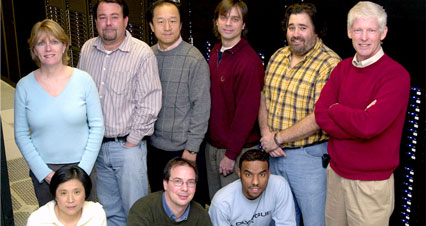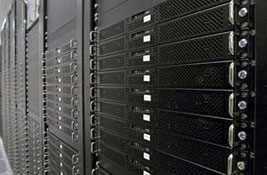2007 News Release
Jefferson Lab Boasts
Virginia's Fastest Computer

Members of the team that installed, prepared and operate the new 7N cluster computer. Back row: Sandy Philpott, David Rackley, Jie Chen, Michael Barnes, Randy Hartman and Chip Watson. Front row: Ying Chen, Balint Joo and Lawrence Sorrillo. Not pictured: Christopher Miller
This is Jefferson Lab's first appearance on the TOP500 Supercomputer Sites list. The 30th edition of the list was released Monday at SC07, the international conference on high performance computing, networking, storage and analysis, in Reno.
The supercomputer, dubbed 7N, runs powerful computer simulations to shed light on how one of the basic forces of nature, the strong force, builds protons, neutrons and other particles from the basic building blocks of matter: quarks and gluons.
The supercomputer is a cluster computer composed of individual units wired together to function as one. It is built of 396 nodes, or individual computers, each containing two Advanced Micro Devices (AMD) quad-core 1.9 GHz processors with four Gigabytes (GB) of onboard random access memory (RAM). The nodes are connected via a Double Data Rate Infiniband network, which is capable of transferring 20 Gigabits of data per second (Gb/s) between the nodes.
These off-the-shelf components were purchased from Koi Computers, a woman-owned, certified Small Disadvantaged Business located in Lombard, Ill. The cluster was originally designed with 432 nodes, each holding two Advanced Micro Devices (AMD) dual-core processors. However, after the Jefferson Lab High-Performance Computing Group evaluated AMD's newest quad-core chips, they decided to exercise an option with Koi to purchase just 396 nodes with the quad cores.
"With our cluster computers here at Jefferson Lab, we have always taken the cost-effective way," says Jie Chen, a Jefferson Lab Senior Computer Scientist and a lead researcher in setting up and testing the supercomputer.

The supercomputer, dubbed 7N, is a cluster computer composed of individual units wired together to function as one. It is built of 396 nodes, or individual computers.
The cluster was installed in Jefferson Lab's Computer Center by the members of the Lab's High-Performance Computing Group in late summer. Koi Computers personnel assisted with the installation. Once installed, it more than tripled the Lab's high-end computing capabilities.
The switch to quad cores also made for a more eco-friendly cluster. The cluster consumes about 20 percent less power than it would have had it been assembled with dual cores. It also functions more than twice as fast as the dual cores, due to the extra two cores on each processor and changes in the internal architecture of the chips. "The quad cores really paid off in increasing the speed of the cluster," Chen says.
The cluster qualified for the TOP500 Supercomputer Sites list by running the Linpack Benchmark, a calculation that's used as a yardstick for supercomputer performance, due to its scalability and uniformity on different platforms. Running Linpack, the cluster ultimately clocked out at 13460 Gigaflops running solidly on 380 nodes.
"It's always a difficult challenge to run a parallel job on all of the nodes at once," Chen comments.
"We're proud that the Department of Energy has provided this incredible resource here at Jefferson Lab for our research into the fundamental structure of matter. Hampton Roads is now home to a supercomputer that's among the world leaders in scientific computing," says Jefferson Lab Chief Information Officer Roy Whitney.
Chen agrees. "This listing puts Jefferson Lab on the map in the high-performance computing community," he says.
Now Chen and his colleagues are focusing on optimizing the system for getting the best physics possible out of the new cluster and on laying the groundwork for the next supercomputer planned for Jefferson Lab.
For more information:
Supercomputing on a Shoestring: Cluster Computers at JLab
Jefferson Lab's Newest Cluster Takes Shape (6N)
Jefferson Lab Awards Contract for Next Cluster Computer (7N)
Jefferson Lab is managed and operated for the U.S. Department of Energy's Office of Science by Jefferson Science Associates, LLC, a joint venture between Southeastern Universities Research Association, Inc. and CSC Applied Technologies Division, LLC.

